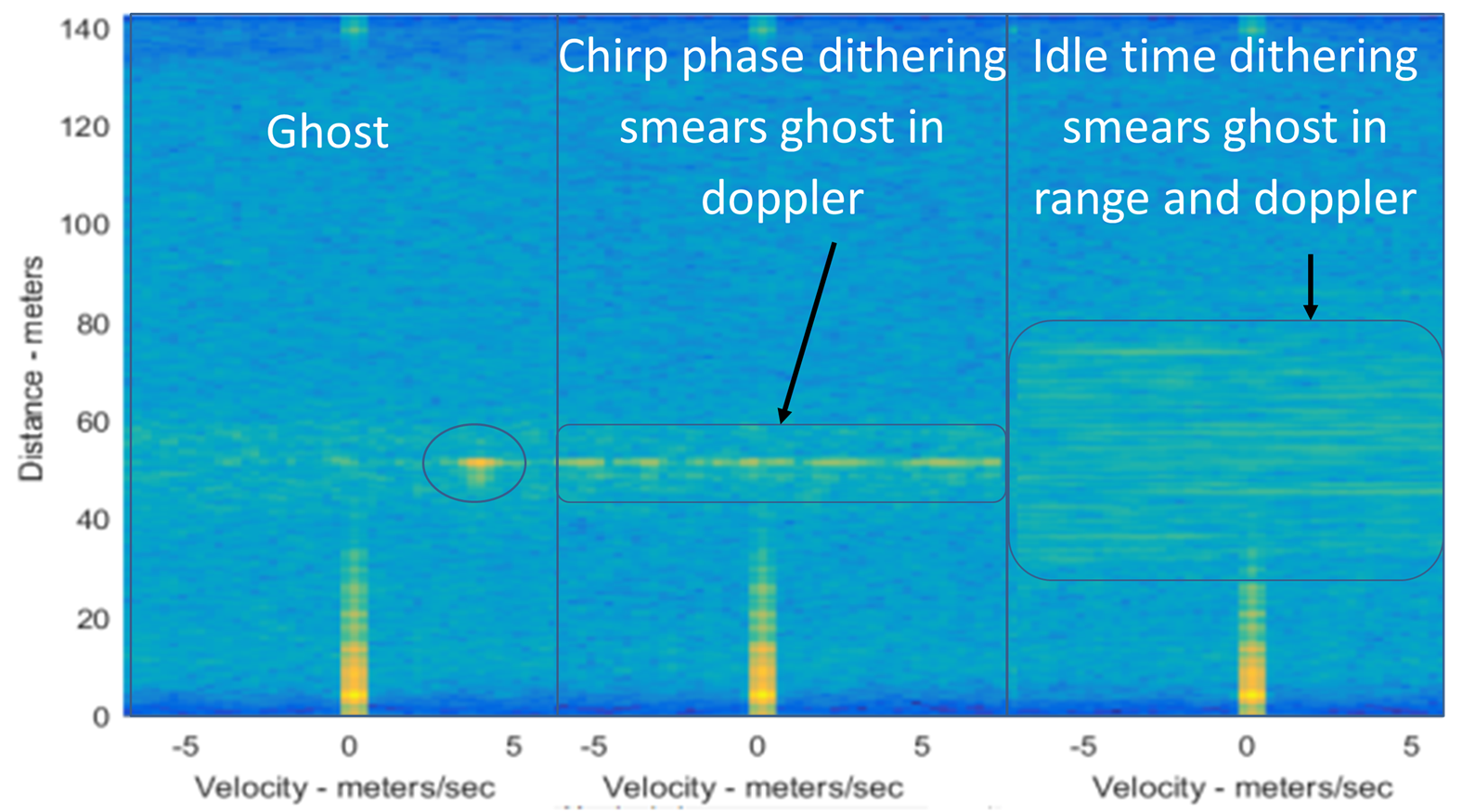SWRA662A January 2020 – September 2022 AWR1243 , AWR1443 , AWR1642 , AWR1843 , AWR1843AOP , AWR2243 , AWR6843 , AWR6843AOP , IWR1443 , IWR1642 , IWR1843 , IWR6443 , IWR6843 , IWR6843AOP
5 Dithering and Randomization
When parallel interference occurs, the whole chirp (or most of the chirp) is damaged, and it is difficult to correct it. Therefore, localization and mitigation is not very useful for parallel interference.
 Figure 5-1 A Ghost from a Parallel Interferer is Spread with Randomized Chirp Phase, and Diffused with Idle-Time Dither
Figure 5-1 A Ghost from a Parallel Interferer is Spread with Randomized Chirp Phase, and Diffused with Idle-Time DitherParallel interferers can be weakened by a process called chirp dithering (or chirp randomization). In this process, certain parameters of a chirp are randomized on a per-chirp basis. For example, the phase of the chirp can be made random. Because the aggressor has no knowledge of the victim’s randomization scheme, a parallel interferer is spread during the doppler processing. The chirp starting phase can be randomized using the per-chirp phase shifter API, or the binary phase shifter API. There are multiple other parameters of a chirp that can be randomized; chirp slope, chirp start frequency, and the chirp idle time can all be randomized using the chirp config API. This chirp config API rlSetChirpConfig is described in the interface control document.
Figure 5-1 shows how a ghost target due to a parallel interferer is spread in Doppler by random binary phase modulation (that is, chirp phase dithering), and further spread using chirp idle time dithering. If no randomization options are used, parallel interferers appear as ghost objects. If randomization is applied, the peak of the interferer is destroyed by dithering. Randomization works by damaging aggressor coherence across different chirps, thereby reducing their effect during 2D processing. The reduction is approximately 10log10 of the number of chirps in one frame. When the aggressor coherence is destroyed, CFAR algorithms can then be used to remove interference-related effects.
Dithering schemes introduce more complexity during Doppler processing, due to the fact that some correction must be applied. For example, chirp phase dithering can be corrected by applying an opposite phase shift to the chirp before Doppler processing. Certain dithering schemes, such as idle time dithering, can introduce high noise-floor in Doppler.
Because oscillators for radar devices vary, without clock synchronization, the chirp starting time moves relatively slowly between the radar devices. For example, two radar devices, programmed to the same chirp configuration, have a 200-ppm difference in local oscillator frequency. Assuming that the chirp must start within 1 µs to see the interference and frame rate is 0.1 s, then after one frame, the relative chirp starting time moves approximately 20 µs. Thus, it takes approximately 1/20 frames to move away from the interference zone. It takes approximately 8 minutes to shift one whole frame to ensure it gets back to the interference zone. Users will see interference in 1/20 frames before it moves away.
When the LO variation is smaller, such as a 1-ppm difference between the two radars, then it takes approximately 27.7 hours to shift back to the interference zone; users will see interference for 10 frames before it moves away. This introduces the possibility of frame start randomization. Each frame starts with a random time offset. In such cases, the parallel interferer may only affect one frame. In this way, the worst case system performance can be improved.